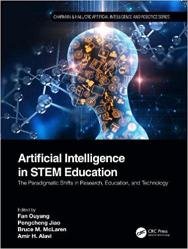Artificial Intelligence in STEM Education: The Paradigmatic Shifts in Research, Education, and Technology
- Добавил: literator
- Дата: 2-12-2022, 19:50
- Комментариев: 0
 Название: Artificial Intelligence in STEM Education: The Paradigmatic Shifts in Research, Education, and Technology
Название: Artificial Intelligence in STEM Education: The Paradigmatic Shifts in Research, Education, and TechnologyАвтор: Fan Ouyang, Pengcheng Jiao, Bruce M. McLaren
Издательство: CRC Press
Серия: Chapman & Hall CRC Artificial Intelligence and Robotics Series
Год: 2022
Страниц: 396
Язык: английский
Формат: pdf (true)
Размер: 36.8 MB
Artificial Intelligence (AI) opens new opportunities for STEM education in K-12, higher education, and professional education contexts. This book summarizes AI in education (AIED) with a particular focus on the research, practice, and technological paradigmatic shifts of AIED in recent years. The 23 chapters in this edited collection track the paradigmatic shifts of AIED in STEM education, discussing how and why the paradigms have shifted, explaining how and in what ways AI techniques have ensured the shifts, and envisioning what directions next-generation AIED is heading in the new era. As a whole, the book illuminates the main paradigms of AI in STEM education, summarizes the AI-enhanced techniques and applications used to enable the paradigms, and discusses AI-enhanced teaching, learning, and design in STEM education. It provides an adapted educational policy so that practitioners can better facilitate the application of AI in STEM education.
Bayesian networks were widely used to make probabilistic inferences based on the learners’ performance data of CBAs. Bayesian networks are a type of probabilistic graphic models, which graphically represent a joint distribution of a set of random variables. Essentially, building a Bayesian network requires the specification of a directed acyclic graph and a table of probability distributions for each variable, or called node, in the graph. Figure 12.1 presents an example Bayesian network with three nodes. In the network, each node represents a random variable and directional edge represents the dependency or the causal relationship between two random variables. The two bottom nodes of squares represent two assessment items indicating learners’ item responses (i.e., correct/incorrect) and the top node of oval represents the latent skill measured by the two items (i.e., mastery/non-mastery). As such, the example network depicts that learners’ probabilities of giving correct or incorrect responses to item 1 and item 2 are dependent on their probabilities of having the latent skill mastered or not.
This book is a must-read for researchers, educators, students, designers, and engineers who are interested in the opportunities and challenges of AI in STEM education.
Скачать Artificial Intelligence in STEM Education: The Paradigmatic Shifts in Research, Education, and Technology
Внимание
Уважаемый посетитель, Вы зашли на сайт как незарегистрированный пользователь.
Мы рекомендуем Вам зарегистрироваться либо войти на сайт под своим именем.
Уважаемый посетитель, Вы зашли на сайт как незарегистрированный пользователь.
Мы рекомендуем Вам зарегистрироваться либо войти на сайт под своим именем.
Информация
Посетители, находящиеся в группе Гости, не могут оставлять комментарии к данной публикации.
Посетители, находящиеся в группе Гости, не могут оставлять комментарии к данной публикации.
